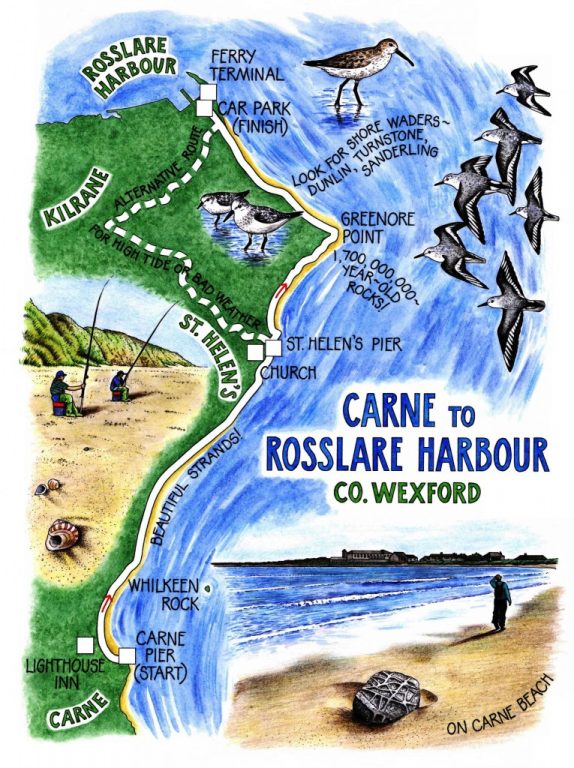Irish Independent – WALK OF THE WEEK – Christopher Somerville
19 December 2009
39. Carne to Rosslare Harbour, Co. Wexford

A glorious winter’s morning on Carne jetty, with a peerless blue sky plastered over County Wexford. There was an acrylic intensity to the yellow oilskins of the fishermen and the scarlet paint of the little boats they were busy loading with the day’s creels. The sea wind was cold, all right, but it blew straight in from the south, with the promise of shoving us along. The strong winter sun, low in the south, lay behind us too, lighting up the cliffs and bellying coastline ahead, elongating our shadows into a pair of flat-out giants that tugged our feet north up the strand.
What a pleasure to be out of the city and down at the shore on such a day! It seemed incredible that in County Sligo, only a few short weeks ago, we had been half drowned and frozen on the wettest of walks out at the Low Rosses. Now we ran like a pair of fools until we’d driven all the breath out of us; then sauntered arm in arm on the sands, letting the great curve of the beach draw the eye on along the low sandy cliffs to vanishing point a couple of miles ahead.
It’s a sandy scene hereabouts; but under the soft demerara granules lie some of the oldest rocks in the land. Out at sea the dark upturned hull of the Whilkeen Rock broke the small waves into foam, and on the strand lay ancient boulders of granite, hulking and sea-smoothed, criss-crossed with thick raised seams like the back of a much-flogged old salt. The sea had performed its usual casual artistry on that morning’s falling tide, strewing the beach with ribbon weeds of shocking pink and lurid green, colours that seemed better suited to some tropical jungle than a cold shore in winter-bound Ireland.
A pair of beach anglers sat stolidly, using their bait boxes as makeshift fishing stools, watching the tips of their sea rods in hopes of a bite. From what? ‘Bass, if we’re lucky,’ they confirmed. ‘Beautiful eating, if you can get ‘em. Maybe a mackerel or two. Maybe some flatfish.’ Brave words, but the catch bag lay empty as yet. There was an even braver man on the sand cliffs near St Helen’s, stripped naked to the waist in the wind and facing the ocean in deep absorption. The prospect was all in shades of blue, from the shot silk and jade of the sea through the smoky blue of the horizon to the hard enamel of the cloudless sky.
The path led over the cliffs. Two donkeys came to the fence, one grey and one black, and put their noses over the wire for half a biscuit each. They stretched their soft rubbery upper lips to hoover the treat off my palm, then crunched ruminatively, licking the crumbs from their long yellow teeth.
Down by St Helen’s pier we found two items bobbing – one red boat by the jetty, and one pied wagtail on a rock. The wagtail proved the opening salvo in a fusillade of bird life. I’d had no idea that the south-east Wexford coast was so brilliant for wintering birds, though I suppose a glance at the map – all those east-facing headlands and beaches as landfalls – should have alerted me. At all events, once we got to Greenore Point the strands came alive with hurrying, stooping, pattering figures: dunlin, down from the Arctic Circle, playing Grandmother’s Footsteps with the oncoming tide; fussy little turnstones with short orange legs, scampering and bickering in groups; a flock of sanderlings all taking off at the same split second, twittering, to swoop with white-edged scimitar wings to a stance a few feet further away from the advancing humans. Just to contemplate the journeys these birds had accomplished to be here made the head spin.
Nondescript, blackish rocks lay in the sea off Greenore Point, drying posts for cormorants with out-held wings. These rocks were ancient when Noah was a lad. They have been lying here for 1,700,000,000 years. That was something to picture as we turned the corner of the headland and made for Rosslare Harbour over a crunchy carpet of clean-picked crab and mussel shells.
WAY TO GO
MAP: OS of Ireland 1:50,000 Discovery 77; detailed map/instructions in ‘Slí Charman’ booklet guide (see below)
TRAVEL:
Rail (www.irishrail.ie) or bus (www.buseireann.ie) to Rosslare Europort; bus service 378, Wexford-Carne; taxi (087-236-6756 or 087-991-0233) to Carne. Road: N25 towards Rosslare Harbour; at Kilrane, right on minor roads to Carne.
WALK DIRECTIONS: From Carne Pier, walk north along coast to Rosslare Harbour – it’s that simple!
NB It’s best to do this walk on a falling tide. High tide can make St Helen’s Pier and Greenore Point impassable, but you can detour inland from St Helen’s to Rosslare Harbour (see map).
LENGTH: 5 miles: allow 2-3 hours
GRADE: Easy
CONDITIONS: Sandy strands or coast path.
DON’T MISS … !
• multicoloured ribbon weed and shells along the strands
• shore waders around Greenore Point
• ancient rocks off Greenore Point – they are 1,700,000,000 years old!
REFRESHMENTS: Lighthouse Inn, Carne (053-913-1131; please ring to check opening times)
GUIDE BOOKS/LEAFLETS: ‘Slí Charman’ booklet guide by Ray McGrath (County Wexford Partnership), available locally and at TIC
INFORMATION: Walking tour operators, local walks including Discover Ireland’s National Loop Walks, walking festivals throughout Ireland: www.discoverireland.ie/walking; www.coillteoutdoors.ie
Glen of Aherlow Winter Walking Festival, Tipperary: 29-31 January (info: www.aherlowhouse.ie)
INFORMATION:
Tourist Office: Kilrane, near Rosslare Harbour (053-916-1155; www.wexfordtourism.com); www.discoverireland.ie/southeast
csomerville@independent.ie
I would like to get in touch with Ray McGrath who does walking tours .We worked together in Montreal, Canada years ago .Can you forward him my email kathleen.mcfall@hotmail.com.thankyou.